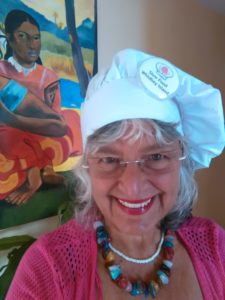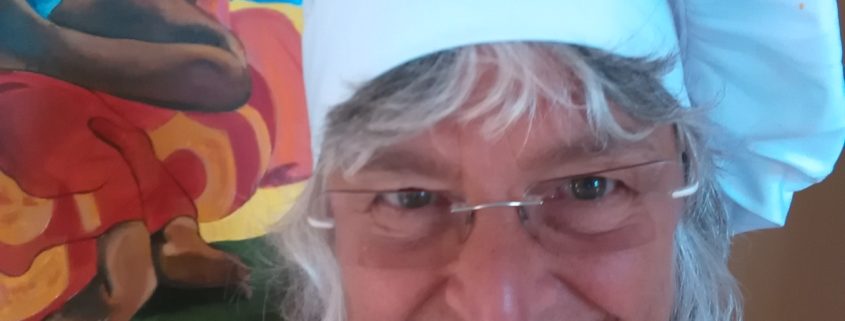Relational Eating—A ten-day local food challenge

By Vicki Robin
This article appeared in our spring 2016 issue. Click here to buy a copy.
At a lovely Fourth of July party, sometime between polishing off an apple pie and watching the funky small-town parade, my eating life turned upside down and inside out. I’d given lip service to the idea of local food, because I espoused it and also sent it past my lips only when convenient. But I was the classic emotional eater: happiness, sadness, celebration, and stress were all eating occasions. I was also the classic American bargain hunter. Cheap, cheap, cheap could have been the sound of buying a Ranger chicken.
Then an organic farmer friend invited me to try a little experiment. She was curious about whether her market garden could produce enough food to actually feed someone for a whole month. I had recently heard that the food system where I live, on a semi-rural island, could not support our population for even half that time. We were, and still are, 95% dependent on off-island sources arriving daily on a ferry or over a narrow bridge.
"I was the classic emotional eater: happiness, sadness, celebration, and stress were all eating occasions."
We shook hands on the deal. She promised to feed me; I promised to blog daily and track the experience, from weight to feelings. In planning for that month, we realized I’d be missing all my standard sources of protein—milk, cheese, meat, eggs—so we drew a circle defined by the distance from her farm to my door. Anything I could find to eat in that radius was in bounds. I also realized there were some staples I could not happily live without: salt, oil, lemons, and caffeine, so those exotics were declared in.
Thus began my ten-mile diet and the transformation not just of my eating but of my sense of home and my passion for shifting our food system back to health. I called this deeper understanding of local food “relational eating”: the shift from being an anywhere-anytime-anything eater to a place-based eater. Food was no longer just what I ate. It was where I belonged.
At the end of the month, I had lost six pounds and gained 25,000 words of daily passionate blogging. I massaged these words into a book, published in 2014 by Viking/Penguin, titled Blessing the Hands that Feed Us: Lessons from a 10-mile Diet.
But the job was not done. Readers wanted support in doing their own local eating experiments. In a flash I saw a way that eaters anywhere could sample what I did and see what happens. Would they have, as I did, an illuminating experience? Would suffer the same setbacks I did, even though a time-limited sprint was a doable and interesting challenge? Would they, as I have, burrow into community and awaken to the politics of our food system? Would they want to be changemakers?
Thus began the Ten-Day Local Food Challenge, designed like a game with a social goal.
"Local represents fresh, lower carbon footprint, flavor, smaller scale, and community bonds between producers and consumers."
Of course conscious eaters, in a quest for both health and ethics, have sought out local food for decades. Local represents fresh, lower carbon footprint, flavor, smaller scale, and community bonds between producers and consumers. And a political movement has been growing, a movement for sovereignty and justice, for land reform and decent pay. Ecologists, gardeners, and farmers see local food through the important lenses of care for soil and water, of fertility, and of diverse, sustainable, and prospering farms.
But local food represents a minuscule portion of our eating pie. Even though local has a lot of mind-share and lip service, how much real estate does it occupy on our plates? How many of our food dollars go into our local economies? How well do our daily choices reflect this aspiration of local eating? My best guess from various sources is that we are between 90-95% industrial-dependent. If we don’t much like the gap between intentions and actions, what then?
Many authors, organizations, and activists have worked to persuade eaters, institutions, and politicians to achieve a healthier food system, supporting local sourcing and affordability. But only a few communities have undertaken local eating campaigns.
Why can’t we, I thought, bring the joy of play and the thrill of contest to the sober work of world changing?
The game:
- For ten days
- Eat food sourced within 100 miles of home
- Allowing ten exotics, foods from afar you can’t live without.
- Commit. Do it. Document it, at least for yourself, possibly to share it forward. Join a Facebook community to see how others are doing it, celebrate wins, and complain as needed.
- How local can you go? Really, pause for a second and scan your 100-mile circle. What would happen if you committed to eat in this circle of home?
Developing the Challenge Campaign:
To share the Challenge I launched a campaign, creating an online platform—website, Facebook page, Facebook group, surveys, and a newsletter. Now, after two years we have 1,000 eaters from half a dozen countries signed up one way or another. Add to that the other 1,000-plus eaters who have done the Challenge without signing up for anything. I hear often from and about these folks.
To be specific, we had nearly 700 likes on our Facebook page, more than 200 in the Facebook group, nearly 500 on our email list, and nearly 200 people who actually took the surveys.
We closed the campaign in 2015, but we expect the Challenge to continue as local groups band together to map their food system; as teachers use it in curricula in schools; as graduate students write papers; and more. All materials are free for the using.
The surprising results:
Surveys from the two years revealed some interesting discoveries that can help us all see what’s needed for communities to take action:
1. The pioneers loved the hunt for food almost more than the food. They loved discovering new sources for their dietary must-haves. A roadside stand. A small sign for “eggs” or “meat.” I made salt from seawater and felt unreasonably proud of myself. However, there is little local food in local grocery stores, so spreading the goodness beyond the pioneers is tough. Some assumed that shopping at a co-op would solve their local sourcing needs, only to discover that co-ops are rarely better than committed grocers in stocking local foods. These are supply chain issues, where stores want to deal with one middle person, not a dozen farmers. Innovations are coming.
2. Pioneers were okay with the need to shop several places (including the forest floor) for food, but busy people with families to feed can't use scant free time for this. Home-delivery services, from one guy who picks up from dozens of growers and delivers to customers to larger scale services (currently mostly organic, not local). The weekly CSA box pick-up is another convenience. But…
3. Pioneers were, of necessity, cooks. They knew how to turn a CSA box into tasty meals. They know what to do with a rutabaga or celeriac or kohlrabi. An increasing crop of Americans, though, have what you could call “cooking deficit disorder.” Whether it’s because of the loss of home economics classes, the rise of convenience foods, or the two income households, cooking from scratch is less and less common. People who buy a cake mix, beating in an egg and water and baking it consider that cooking. Or pouring bottled dressing on bagged baby greens. Of course this is fresher and more engaged than eating out or ordering in a pizza, but it doesn’t equip people to deal with a farmers’ market haul. Some chefs are building businesses around local food restaurants or home delivery meal services, but our hope is that cooking will return to the classroom. Call it life skills or the maker revolution, but young people are ready to learn how to DO and BUILD stuff—real stuff like food, not just apps.
4. Most rewarding, though, was that these eaters discovered the deeper joys of relational eating. Some will spend up to 30% more for fresh local produce; they find that eating with the seasons as each crop ripens means local food is often less expensive. They want to share the Challenge with friends and family. Some, I’m sure, will become more active in food system issues.
"We shook hands on the deal. She promised to feed me; I promised to blog daily and track the experience, from weight to feelings."
The Ten-Day Local Food Challenge, then, is a short sprint to test a value we hold but don’t always practice. Being a game, it invites play rather than guilt. It’s a way to investigate one’s own eating patterns and to eat better; not out of self-limitation, but because we respect the food and the farmers who grow it. It’s a way to pierce through the illusion that we have everything at hand we could ever want, and see the problems with our mega-supply chains and mega-stores. It’s an encouragement to stay put and root somewhere among real people. In an era of so much displacement with great distances between loved ones, buying and sharing local food is a visceral way to re-weave the bonds of community.
My Ten-Mile diet put me on a road home. What’s your experience of local food? If you are committed, look around your community. What’s in the way of everyone having the relationship with food you have? Do the discoveries of the local food pioneers resonate with you? What bright ideas about sourcing, distributing, cooking, and eating local food have people in your community innovated?
Local food isn’t a thing, a product. It’s a process. And it’s stories. Is it woven into your story?
Vicki Robin is a community builder, a social innovator and activist, writer, and speaker. She is coauthor with Joe Dominguez of the New York Times Best-seller, Your Money or Your Life: Transforming Your Relationship With Money and Achieving Financial Independence (Viking Penguin, 1992, 1998, 2008). Blessing the Hands that Feed Us: What eating closer to home can teach us about food, community and our place on earth (Viking/Penguin 2014) is the story of her discovery of relational-eating on Whidbey Island, WA.




Leave a Reply
Want to join the discussion?Feel free to contribute!